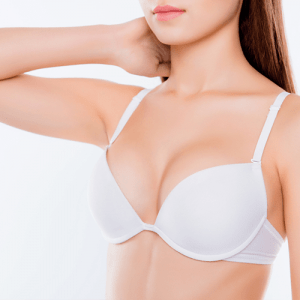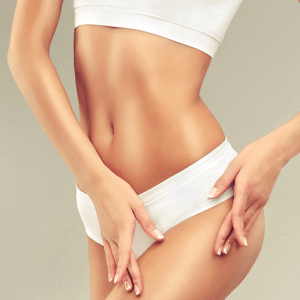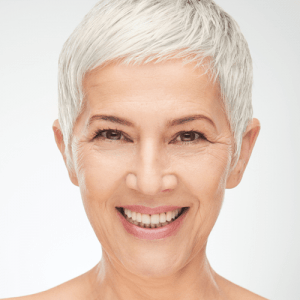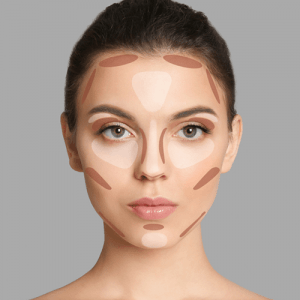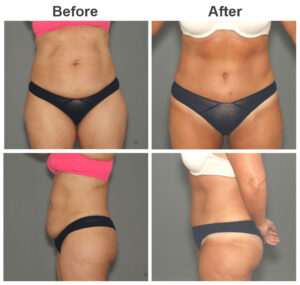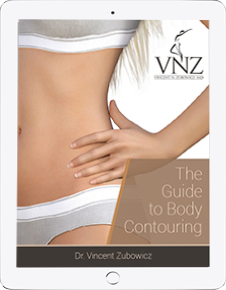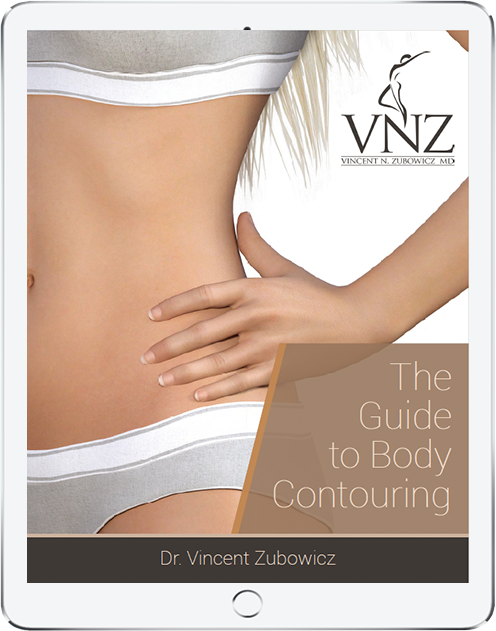Liposuction
Liposuction is one of the safest and most productive operations in plastic surgery. In properly selected patients, unwanted bulges and prominence can be eliminated by a short operation with almost no scarring. The operation is extremely safe with a relatively rapid recovery.
General anesthesia is seldom required for the procedure. Most patients have the operation with oral sedation and tumescent preparation of the fat. Most patients state that there is very little actual pain, usually described as soreness when moving around for several days after the operation.
In this video, Dr. Zubowicz discusses liposuction. He reviews how the procedure is performed and talks about the recovery time.
What Are the Different Types of Liposuction?
All types of liposuction involve removal of unwanted fat by aspiration. Variations in technique prepare the fat differently for its ultimate removal. Each of the preparations will be examined separately, but the common denominator is the removal of the final product by negative pressure (suction).
We offer conventional liposuction, mechanically assisted liposuction, ultrasonically liposuction, and laser-assisted liposuction:
- Conventional liposuction uses strong negative pressure (suction) to physically remove fat. A cannula is inserted through the skin and passed multiple times through the treatment area.
- Mechanically assisted liposuction is a technique where conventional liposuction is assisted by rapid mechanical reciprocation generated by an electric motor. In addition to saving the surgeon arm fatigue, the agitation assists in making the fat more available for removal, particularly in places where there is a lot of connective tissue.
- Ultrasonically assisted liposuction uses ultrasound energy to break down the fat which is concurrently suctioned using the conventional technique. In addition to this enhanced fat delivery, ultrasonic energy is converted in thermal damage that may help tighten skin and the connective tissue anchoring the skin to the underlying muscle.
- Laser assisted liposuction uses laser energy via a glass fiber line. A preset amount of energy is delivered to a given area to break down the fat cells and create thermal injury to help tighten the skin and connective tissue. The laser line is removed and the byproduct of this laser treatment is removed by conventional suction or mechanically assisted liposuction.
Except in exceptional cases, I have abandoned the use of laser assisted and ultrasonically assisted liposuction. These techniques do not deliver better results and create unwanted thermal damage and scarring to otherwise healthy tissue.
In this video, Dr. Zubowicz describes different types of liposuction.
What is Tumescent Liposuction?
Tumescence is not liposuction at all but a preparation of the fat for removal. It is used in almost all cases. The technique involves filling the fat with a dilute solution of lidocaine (an anesthetic) and epinephrine (to reduce bleeding and bruising). It also makes passage of the liposuction cannula (the tube that removes the fat) physically easier for the surgeon.
In this video, Dr. Zubowicz describes Tumescent Liposuction.
Am I a Good Candidate for Liposuction?
Ironically, the best results from liposuction are in thinner patients. The ideal candidate is slender with an isolated area of fat that is disproportionate to the rest of the body. Correction is accomplished by removing the unwanted fat by gentle suction. Liposuction is not a weight reduction operation. Patients who look to the procedure to obtain significant weight loss will be disappointed.
Liposuction also requires that the skin over the area to be treated will adjust to the decrease in fat volume. Removal of fat changes the volume of tissue between the skin and the underlying muscle. The surface area of the skin must shrink to prevent irregularities of contour. Younger patients (with youthful skin) therefore are the best candidates.
Imagine a balloon and a beach ball both filled with air. If one removes some air from the balloon, the surface remains smooth because the rubber in the balloon shrinks enough to prevent rippling. On the other hand, remove air from the beach ball and all sorts of surface distortions occur. This is because the beach ball’s “skin” can only decrease in surface area so much. Additional reductions in volume are accompanied by “gathering up” of redundant surface skin. This results in dimples, wrinkles, or folds.
Obviously, balloon skin is preferred to beach ball skin for the liposuction patient. It is important in the pre-operative assessment to identify those patients whose skin will respond favorably and those who will not. Experience with the management of patients of all skin types allows the surgeon to comfortably predict who is and who is not a good candidate.
Patients may also have prominences produced by situations other than excess fat. After pregnancy, for instance, the abdominal muscles may be stretched forward creating a pot-belly look. This may occur even in women who are quite thin. Liposuction will have little effect on this group of patients. Formal reconstruction of the abdominal musculature in combination with liposuction will generate the best result. Once again, the experienced surgeon will be able to make an accurate assessment.
In this video, Dr. Zubowicz answers the question, Who is a good candidate for liposuction?
Is Liposuction Safe?
Liposuction is a very simple and one of the safest operations when performed in the hands of experienced and properly trained surgeon. The procedure does require some form of anesthesia which creates the major risk for the operation. It is important that the patient understand the capabilities of the surgeon and the circumstances under which the operation will be performed.
Liposuction should be performed only by certified plastic surgeons who perform the operation more than occasionally. The surgeon should be able to clearly explain the expectations and risks for each patient. There should be photographs of the physician’s work to review.
In this video, Dr. Zubowicz discusses the safety of liposuction.
What is Recovery from Liposuction Like?
Liposuction requires only small puncture sites for access, not formal incisions. Therefore, wound management is relatively easy. No significant scars result from the procedure, and there is effectively no incisional pain. Patients complain of soreness over the areas treated, not much pain. Nevertheless, pain medicine is prescribed for the first several days after the operation should the patient need it.
Patients are allowed to walk around as soon as they recover from the anesthetic. This must be limited somewhat in patients undergoing suction of the legs to diminish swelling. Absolute bed rest is not required, but attention must be paid to swelling that may result if patients are on their feet for too long.
Patients may be taped in occasional circumstances but usually, only a garment is needed to apply gentle pressure to the treated areas.
In this video, Dr. Zubowicz talks about liposuction recovery.
Request a Liposuction Consultation
Dr. Zubowicz is a board-certified plastic surgeon and has been firmly established in the Atlanta medical community for over thirty-five years. He obtained his medical degree from University of Kansas and completed his residency at Emory University Affiliated Hospitals.
He is available for consultations at either the Midtown Atlanta or Milton location. During the consultation, Dr. Zubowicz will discuss your goals, explain the process and determine if you are a good candidate for liposuction surgery. Fill out the form to schedule your consultation.
Liposuction FAQs
Written and reviewed by:
This article was written by Dr. Vincent Zubowicz, who is board certified by the American Board of Plastic and Reconstructive Surgery. He practices medicine at his offices in Milton and Atlanta. Learn more about Dr. Zubowicz, his medical training, and credentials.
Customer Reviews


Dr. Vincent Zubowicz is one of the Atlanta areas top plastic and reconstructive surgeons. He is an expert in cosmetic surgery, with years of experience performing many plastic surgery procedures. He offers a personal, customized approach and is dedicated to helping patients achieve the most natural looking results.
Call our office at 470-462-2917 to schedule your consultation with Dr. Vincent Zubowicz.


